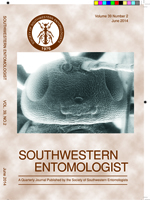Onion (Allium cepa L.) is the most economically important monocot besides grasses. The crop suffers severe damage from onion thrips, Thrips tabaci Lindeman, a cosmopolitan and polyphagous insect pest. In addition to causing direct feeding damage, onion thrips is the principal vector of the economically important Iris yellow spot virus (Tospovirus sp., family Bunyaviridae). Any attempt to manage this pathosystem will require a multifaceted approach based on integrated pest management. Host plant resistance is an important foundation to the success of such approaches. A multi-state, multi-disciplinary research project was established to identify, validate, and deliver resistance to this pathosystem for use by the onion industry. As part of the project, diverse onion plant introduction (PI) accessions from the USDA germplasm collection, advanced breeding lines, and commercial cultivars were evaluated from 2009 through 2011 in fields in Colorado. Sixteen, 15, and 10 better performing onion genotypes were selected in 2009, 2010, and 2011, respectively. Of these, PI 264320 (Grano), PI 546140 (San Joaquin), and PI 546192 (Yellow Sweet Spanish) were selected in both 2009 and 2010, and PI 258956 (Calderana 1028) and PI 546188 (Yellow Sweet Spanish Winegar) were selected in all 3 years. These genotypes should be useful to improve commercial cultivars to reduce losses by the two pests.
How to translate text using browser tools
1 June 2014
Evaluation of Onion Germplasm for Resistance to Iris Yellow Spot (Iris yellow spot virus) and Onion Thrips, Thrips tabaci
C. O. Boateng,
H. F. Schwartz,
M. J. Havey,
K. Otto
ACCESS THE FULL ARTICLE

Southwestern Entomologist
Vol. 39 • No. 2
June 2014
Vol. 39 • No. 2
June 2014




